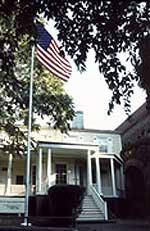





Survey of Historic Sites and Buildings
  |
HAMILTON GRANGE NATIONAL MONUMENT New York |
 Hamilton Grange National Monument |
| ||
In 1962 the President signed the act of Congress that authorized creation of Hamilton Grange National Monument in honor of Alexander Hamilton, Founding Father, first Secretary of the Treasury, and brilliant financial and political leader. The Hamilton Grange, one of the few Federal-period houses still standing in New York City, is the only home ever owned by Hamilton and the only extant structure that possesses an intimate association with Hamilton. The other houses that he occupied in New York City have been torn down, and the House of Morgan building occupies the site of his law office, across from Federal Hall National Memorial.
In 1795 Hamilton resigned as Secretary of the Treasury and returned to New York to practice law, although he continued to take an active part in national affairs. In 1800 he purchased a 16-acre tract of land on the pleasant wooded hills overlooking the Hudson River, north of the town of New York; later he purchased the adjacent 16 acres. Workmen constructed the house in 1801-2 at a cost of £1,500. The architect was John McComb, designer of New York City Hall and other distinguished buildings. Taking much pleasure in planning and supervising the construction, Hamilton named the estate "The Grange" after that of his paternal grandfather, Alexander Hamilton, Laird of the Grange, in Ayrshire, Scotland.
Hamilton lived in the house only 2 years, until July 11, 1804, when he died after a duel with Aaron Burr. Hamilton spent the night before the duel in his study writing a farewell letter to his wife. After his death Mrs. Hamilton moved to downtown New York and in 1833 sold the house, which had a series of owners until 1889. In that year St. Luke's Protestant Episcopal Church purchased it, moved it 500 feet from its original location, and used it as a temporary chapel. At that time workmen removed the front and back porches and made other alterations. In 1924, when the threat to the preservation of the house became acute, two financiers, George F. Baker, Sr., and J. P. Morgan, purchased it, conveyed it to the American Scenic and Historic Preservation Society, and set up a $50,000 trust fund to maintain it as a memorial to Hamilton and a museum of his times.
Encroachments on its former location had obscured Hamilton Grange. Despite modifications, the basic structure was still intact, though in need of extensive renovation. Its design is simple but dignified. The two-story frame structure has brick-filled walls and partitions. The original siding, hand-hewn attic beams, hand-split lath, and ornamental plaster mouldings are preserved. In 1962, to make possible a National Monument to Hamilton in a suitable location, the American Scenic and Historic Preservation Society donated the house to the Federal Government and the city of New York deeded the land for the relocation. The National Park Service has moved the Grange to the new site, completely restored and furnished it with some of the Hamilton furniture and memorabilia now in the house and others promised by family descendants, and it is now open to the public.
NHL Designation: 12/19/60
 |
 |
http://www.cr.nps.gov/history/online_books/founders-frontiersmen/sitea23.htm
Last Updated: 29-Aug-2005